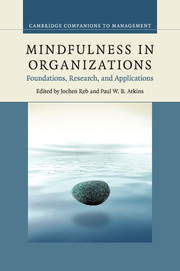Book contents
- Frontmatter
- Contents
- List of figures
- List of tables
- List of contributors
- Foreword
- Preface
- Part I Foundations
- 1 Introduction
- 2 What is mindfulness, and why should organizations care about it?
- 3 Mindfulness: historical and contemplative context and recent developments
- 4 Methods of mindfulness: how mindfulness is studied in the workplace
- 5 Applying mindfulness in the context of work: mindfulness-based interventions
- Part II Research
- Part III Applications
- Index
- References
5 - Applying mindfulness in the context of work: mindfulness-based interventions
from Part I - Foundations
Published online by Cambridge University Press: 05 July 2015
- Frontmatter
- Contents
- List of figures
- List of tables
- List of contributors
- Foreword
- Preface
- Part I Foundations
- 1 Introduction
- 2 What is mindfulness, and why should organizations care about it?
- 3 Mindfulness: historical and contemplative context and recent developments
- 4 Methods of mindfulness: how mindfulness is studied in the workplace
- 5 Applying mindfulness in the context of work: mindfulness-based interventions
- Part II Research
- Part III Applications
- Index
- References
Summary
Introduction
Since its introduction to the mainstream of western medicine and society in the late 1970s (Kabat-Zinn 1990), mindfulness has received considerable scholarly attention. Over the last decade, scientific research on mindfulness has increased strongly, approaching the concept from both a practical and theoretical angle. For instance, different mindfulness training programs have been developed and tested, using a wide range of target populations. Training programs such as mindfulness-based stress reduction (MBSR; Kabat-Zinn 1982), mindfulness-based cognitive therapy (MBCT; Segal, Williams, and Teasdale 2002), and mindfulness-based eating awareness training (Kristeller, Baer, and Quillian Wolever 2006), have been used successfully to treat emotional and behavioral disorders, such as borderline personality disorder, major depression, chronic pain, or eating disorders (cf. Bishop et al. 2004). A growing body of empirical research has found evidence for the effectiveness of mindfulness-based interventions (MBIs) (a) to reduce symptoms in clinical samples (for meta-analytic reviews, see Bohlmeijer et al. 2010) and (b) to promote psychological wellbeing in non-clinical samples (Collard, Avny, and Boniwell 2008). Besides its practical application, different studies have attempted to uncover the underlying mechanisms of mindfulness, aiming to understand the construct in terms of processes such as self-regulation, impulsivity, executive functioning, and memory (see, for instance, Fetterman et al. 2010).
While mindfulness has achieved an undeniable position in the field of clinical and personality psychology, it has only recently started to gain attention in the field of industrial and organizational (IO) psychology and organizational scholarship. Theoretical papers have discussed the role of mindfulness for performance (Dane and Brummel 2014), employee wellbeing (Glomb et al. 2011), and relationships (Atkins and Parker 2012). Furthermore, a number of empirical studies have recently been published, focusing mostly on trait mindfulness and MBIs.
Information
- Type
- Chapter
- Information
- Mindfulness in OrganizationsFoundations, Research, and Applications, pp. 100 - 132Publisher: Cambridge University PressPrint publication year: 2015
References
Accessibility standard: Unknown
Why this information is here
This section outlines the accessibility features of this content - including support for screen readers, full keyboard navigation and high-contrast display options. This may not be relevant for you.Accessibility Information
- 16
- Cited by
